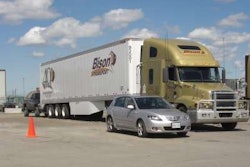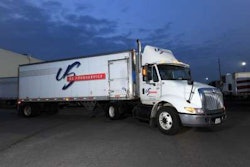Fatality rate at lowest ever recorded
The number of truck-involved traffic fatalities declined 12 percent in 2008, dropping from 4,822 in 2007 to 4,229, the National Highway Traffic Safety Administration said. In addition, the number of truck occupant deaths decreased 16 percent in 2008, from 805 in 2007 to 677. The truck-involved fatality rate is now at its lowest since the U.S. Department of Transportation began keeping those statistics in 1975.
“This achievement is great for all highway users,” says Bill Graves, president and chief executive officer of the American Trucking Associations. “We must build upon this and look toward long-term improvements.”
The overall number of people killed in motor vehicle crashes in the United States decreased 9.7 percent from 41,259 in 2007 to 37,261 in 2008, the lowest level since 1961. The fatality rate for 2008 was 1.27 persons per 100 million vehicle miles traveled, about 7 percent below the rate of 1.36 recorded for 2007.
Substantial declines occurred in virtually every major category, led by declines in passenger car occupant fatalities, which dropped for the sixth year in a row, reaching the lowest level since DOT began keeping records. Light truck occupant fatalities fell for the third straight year. Alcohol-impaired fatalities also declined by more than 9 percent over 2007.
NHTSA’s 2008 traffic safety data can be found at www-nrd.nhtsa.dot.gov/Pubs/811172.pdf.
Roadcheck 2009 sets safety marks
Roadcheck 2009’s record total of overall inspections and Level I inspections showed significant declines in vehicle and driver out-of-service rates, as well as a significant drop in safety belt violations, the Commercial Vehicle Safety Alliance announced. During the 72-hour period from June 2-4, about 9,700 CVSA and Federal Motor Carrier Safety Administration-certified inspectors at 2,148 locations across North America performed a record 72,782 truck and bus inspections; of that total, there were 57,013 North American Standard (NAS) Level I inspections. Roadcheck results include the following, according to CVSA:
·Data show the highest overall vehicle compliance rate – 80.4 percent – since 1996, and the highest overall driver compliance rate – 95.7 percent – ever;
·For NAS Level I inspections, the compliance rates of 77.8 percent (vehicles) and 96.1 percent (drivers) both were records for Roadcheck, and represented 7.1 and 20.4 percent improvements, respectively, over last year’s totals;
·Safety belt violations were reduced in 2009 by 276 (1,246 to 970), a 22.2 percent improvement over last year; and
·Inspections of passenger-carrying vehicles resulted in a vehicle compliance rate of 88.5 percent and a driver compliance rate of 96.4 percent, both improvements (5.7 percent for vehicles and 20 percent for drivers) over last year’s totals.
Preventable or not: Doe gets sidetracked
Rejuvenated by a weekend spent target shooting, playing poker and fine-tuning a friend’s awesomely-loud Chevy hot rod, trucker John Doe happily hit the road with a tanker load of milk in tow. But, alas, traffic was getting heavy as Doe approached a railroad crossing (the gate was raised), which preceded the intersection with Route 222, where he had to turn left.
Doe’s tractor-trailer was moving at a snail’s pace in the inside lane, inches from the bumper of the car ahead, when the traffic signal at the intersection turned red, thereby stranding the posterior of his trailer astride on the tracks. Fearful of being waffled by a train, Doe jacked his rig off the tracks and into a fortuitous break in the divided highway, waiting for the light to change.
To alert the driver ahead of his close proximity (nearly touching the car’s left rear door), Doe tapped his horn – to no avail, because the car’s youthful, habitually-spaced-out and partially deaf driver, Rebecca “Becker” Bumby, had her iPod cranked to the max, with her earplugs muffling any outside noise. When the light changed, Becker hit the gas and












